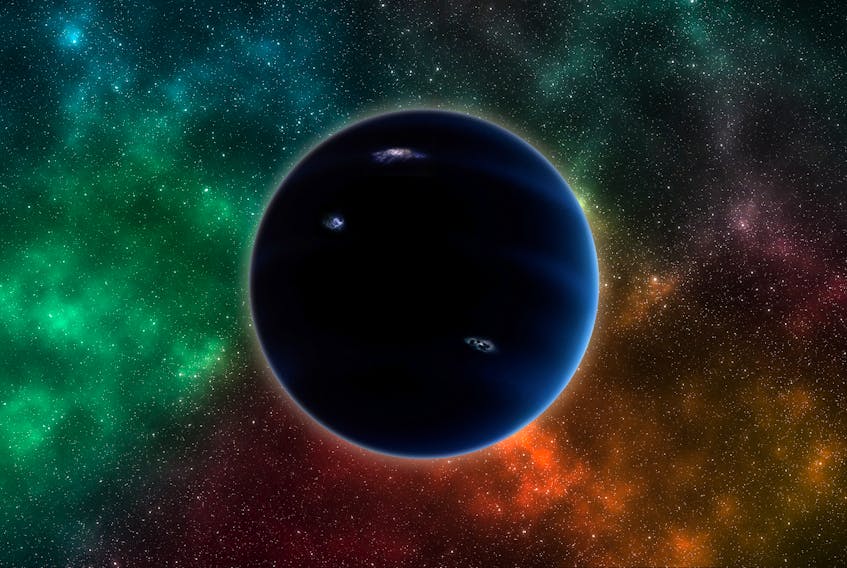Planet X and Great-Uncle George have something in common - both are thought to exist, but no one has actually seen either of them.
I know, I know....who the heck is Great-Uncle George, and what does he have to do with Planet X?
Many families have a Great-Uncle George - that family member who is listed in the family registry, but who no one has ever seen, though he is reputed to periodically send postcards to far-off, distant family members (none of whom you've ever personally met, and only have blurry, faded pictures of) when he happens to be in their neighbourhood. He is believed to be an extreme recluse, living at the very edge of civilization (perhaps in the wilds of the Amazon jungle), and like all elusive, shadowy individuals, is attributed to larger-than-life qualities.
Like Great-Uncle George, Planet X is an enigma. It is theorized to be a super-sized planet that orbits well beyond the orbit of Neptune. Its existence (like that of Great-Uncle George) is surmised, not by direct visual observation (at least not to date), but, rather, by its influence on several trans-Neptunian (meaning "outside the orbit of Neptune") objects in the Kuiper Belt, a doughnut-shaped ring of icy objects beyond Neptune.
Over the past two decades, several large Kuiper Belt objects have been discovered, including the dwarf planets Sedna (2003) and Eris (2005), as well as smaller objects such as VP 113 ("Biden") in 2012, TG387 ("The Goblin") in 2015, and VG18 ("Farout") and AG37 ("Farfarout") in 2018; the latter object now designated, to date, the farthest orbiting object in our solar system.
Except for the orbits of Sedna and Biden (which do not approach Neptune), the orbits of the other distant objects all swing out in one direction from the sun (something that should not normally occur). Astronomers surmise that this is due to the gravitational influence of a massive, as yet undiscovered, object labelled Planet X, somewhere in the neighbourhood.
It is now believed that this hypothetical Planet X has an orbit 20 times that of Neptune. At such a distance, Planet X, if it exists, would take approximately 1,000 years to complete one full orbit around the sun. Preliminary calculations put its size at four times that of Earth, with a mass about 10 times that of our planet (somewhat less than the mass of Neptune).
Each time astronomers locate another far-flung object at the extreme edge of our solar system (such as recently-found Farout and Farfarout), and indications show that their orbits are shaped by the gravitational influence of a massive celestial object in their neighbourhood, the case for the existence of Planet X is strengthened. It is only a matter of time, as larger telescopes are developed and trained skyward, and as the potential location of the elusive planet is narrowed down, that Planet X will be found, or some other explanation put forth. If Planet X is discovered, it will become the ninth planet of our solar system, replacing once-noble Pluto, now sadly demoted to dwarf planet status.
Now, about Great-Uncle George. Do we really want to find him? Wouldn't it be more fun to keep him as one of those elusive, colourful, eccentric family members who everyone talks about at the annual family gathering, and who just might appear completely out of the blue one day? Wait a minute, was that the doorbell?
This week's sky
It will be very challenging to view Mercury (magnitude +0.5, in Capricornus - the Sea Goat) this coming week. It makes its highest appearance (its greatest elongation west of the sun) in the pre-dawn, southeast sky on Feb. 24, reaching an altitude of approximately 10 degrees above the horizon, though it may be difficult to spot in the pre-dawn glow.
Likewise, Jupiter (magnitude -1.9, in Capricornus), though bright, will be difficult to spot, barely reaching two degrees above the east-southeast horizon at dawn.
Saturn (magnitude +0.7, in Capricornus) rises no higher than nine degrees above the northwest horizon at dusk.
Mars (magnitude +0.9, in Taurus - the Bull) is visible 61 degrees above the southwest horizon by about 6:30 p.m., remaining observable until it sets shortly after 1 a.m. Look for Mars to the lower left of the Pleiades ("Seven Sisters") star cluster on Feb. 28, about halfway up the southern sky as the sky darkens. Compare the reddish colour of Mars with that of the reddish star Aldebaran, the "eye" of the bull, Taurus.
Venus, close to the sun, is not observable this week.
The full moon on Feb. 27 was referred to by the indigenous tribes of North America as the "snow moon", as February was often the month of winter's heaviest snowfalls.
Until next week, clear skies.
Events:
- Feb. 27 - Full ("Snow") Moon
- Feb. 28 - Mars to lower left of Pleiades star cluster
Glenn K. Roberts lives in Stratford, P.E.I., and has been an avid amateur astronomer since he was a small child. He welcomes comments from readers at [email protected].








